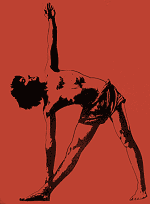 Thinking of starting yoga? Can’t get past the jargon? Maybe this will help.
Thinking of starting yoga? Can’t get past the jargon? Maybe this will help.
Yoga includes three main parts.
Postures (Asanas)
- Gentle stretches used as exercise
- Held briefly to relieve tension, build endurance, and improve circulation
- Hundreds of postures
Breathing (Pranayama)
- Deep breathing exercises
- Combined with the yoga postures
- Focused, calculated, and taken through the nose
- Helps increase the flow of oxygen and nutrients
- Reduces stress and lifts depression
Meditation (Dhayana)
- Yoga followers are encouraged to let their worries go
- Many people focus on a single object in the room or repeat mantras (repeated word or phrase) to achieve this meditative state
There are several types of yoga practices. Depending on your physical needs, one type might be more beneficial to you.
Hatha Yoga
- Very mellow and slow form of yoga
- Among the most commonly practiced types of yoga
- Focuses on simple, flowing poses
- Practitioners are encouraged to perform exercises at their own pace while focusing on breathing and meditation
Ashtanga Yoga
- Known as power yoga
- More physically demanding
- Requires practitioners to hold poses
- Focuses on increasing muscle strength and stamina
- Less focus on breathing and meditation
- Athletes generally enjoy Ashtanga yoga
Bikram Yoga
- Very challenging
- Performed in a heated room
- Practitioners focus on 26 postures performed in order
- Must be extremely physically fit
Viniyoga
- Popular among seniors, people recovering from injuries, or dealing with chronic pain
- Slower, more individualized
- Increases strength, coordination, and balance
8/23/06 23;51 JR